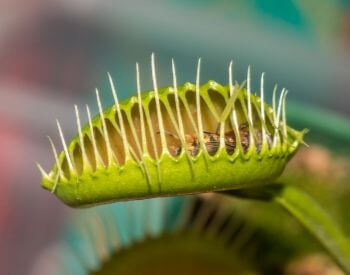
- Common Name: Venus Flytrap
- Scientific Name: Dionaea muscipula
- Genus: Dionaea
- Family: Droseraceae
- Order: Caryophyllales
- Distribution: Coastal plain of North and South Carolina, USA
23 Venus Flytrap Facts for Kids
- The Venus flytrap is a carnivorous plant native to the United States of America.
- The Venus flytrap is the most recognized and grown carnivorous plant in the world.
- The scientific name for the Venus flytrap is Dionaea muscipula.
- The Venus flytrap grows on the East Coast of the USA in the subtropical wetlands of North and South Carolina.
- British colonial governor Arthur Dobbs discovered the Venus flytrap in 1759.
- British naturalist John Ellis first described the Venus flytrap in 1768.
- The Venus flytrap captures insects and uses them as a source of nutrients. However, the Venus flytrap still produces energy using sunlight and the photosynthesis process.
- Botanists have determined the Venus flytrap prefers a specific type of prey. A study revealed the diet of a Venus flytrap consisted of ants, beetles, flying insects, grasshoppers and spiders. Contrary to its name, less than 5% of its diet consists of flying insects.
- The Venus flytrap is one of a few plants with the ability to create a rapid movement.
- The trap used by a Venus flytrap contains hairs that can trigger it to close when they detect an insect.
- The hairs of the Venus flytrap have evolved to prevent false closing from things like raindrops and wind.
- An insect must trigger two of the hairs on a Venus flytrap, within about 20 seconds to trigger it to close.
- The trap of the Venus flytrap closes shut in about 1/10th of a second after its been triggered.
- Once the trap is closed, an insect will need to continuously trigger hairs to stimulate digestion.
- If an insect successfully stimulates digestion the trap creates an airtight seal and start to digest it.
- An insect successfully captured by a Venus flytrap can take up to ten days to fully digest.
- Once the insect has been digested the trap reopens and is ready to capture another insect.
- The Venus flytrap is a very popular plant and it’s commonly sold as a household plant.
- The U.S. State of North Carolina designated the Venus flytrap as the State Carnivorous Plant in 2005.
- The wild population of the Venus Flytrap has dropped more than 90% between 1979 and 2019.
- In 1979, the wild population of the Venus flytrap was estimated to be around 4.5 million individual plants.
- In 2019, a survey by the North Carolina Natural Heritage Program estimated the wild population of the Venus flytrap was around 302,000 individual plants.
- Due to destruction of habitat and illegal harvesting (poaching) the Venus flytrap is classified as a vulnerable species by the International Union for Conservation of Nature (IUCN).
Pictures of the Venus Flytrap

A picture of a venus flytrap with a fly.

A picture of a venus flytrap with an ant.

A picture of a venus flytrap with a bee.
Find More Facts About the Venus Flytrap
- About the Venus Flytrap – Learn more about the Venus flytrap (Dionaea muscipula) on the Botanical Society of America website.
- Venus Flytrap Video – A YouTube video by the BBC showing a Venus flytrap catching a fly.
- More Venus Flytrap Facts – Find more shocking facts about the Venus flytrap on the Live Science website.
- How to Grow a Venus Flytrap – Discover how you can grow your own Venus flytrap on the Tom’s Carnivores website.
